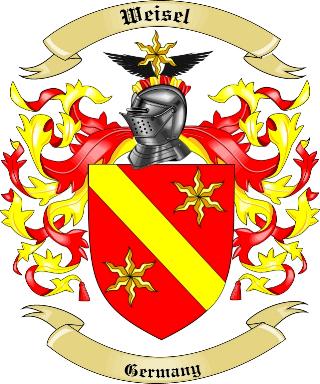During the course of our research into the name Weisel we have traced its
origin
to West Prussia. Similar to East Prussia, this state on the river Vistula (Weichsel)
used to belong to the Order of the German Knights. The Teutonic Order,
as they
are also named, was composed of pious noblemen who had participated in
the
Crusades.
They expanded their territories eastwards, supporting their
colonization
by building fortresses as they moved. Except for some church territories, the Order's
empire stretched from here to the land of Estonia on the Baltic coast. to
West Prussia. It
was a Polish territory under the Duchy of Pomerellen until 1309, when the
Order made
it a part of its territory.
The knights founded Elbing, Thorn, Culm, and
Graudenz, and
built several fortified castles, the most famous being Marienburg, an architectural
jewel on the river Nogat that was the seat of the Order's "Hochmeister"
(grand master).
Under the protection of the Order's fortified castles, German farmers colonized the
rich lands and developed the soil's potential, while the Slavic tribes
were converted to
Christianity. Here the Weichsel (Vistula) plain was an ideal area for
growing crops such
as wheat and sugar beets. Towns were built according to plan, rather than allowed to
expand by chance, one of the first uses of urban planning in the Middle
Ages.
During the medieval period, members of the Weisel family were found in
West Prussia
and Pomerelia, where the name emerged in medieval times as one of the
notable families
in the western region. From the 13th century onwards the surname was identified with
the great social and economic evolution which made this territory a landmark contributor
to the development of the nation.
Throughout the course of history, the spelling of a name may even vary
from father to son,
as the name evolved and changed with the German language. Since only the
scribes
could read and write, names were often recorded based on the way they sounded, which
produced great variations due to regional dialects. It was also common
in German to
add elements to a name, which gave information about the person's religion, place of origin,
or even character. Variations of the family name Weisel include Wessling
, Weseling,
Wesseling, Wesslin, Weselin, Wesselin, Weissling, Weisseling, Weiseling,
Wesling,
Weissling, Weselling, Wesselling, to name a few examples.
After the Order broke up in 1466, West Prussia became a "class state" under the protection
of the Polish King. This form of government worked by mutual agreement
between the
different levels of society: the nobility, church, the citizens, and the free landholders. In 1569
a large part of West Prussia came completely under Polish domination, until it was incorporated
as a province in the expanding state of Brandenburg-Prussia in 1772, after the partition of
Poland, Danzig and Thorn remained Polish until 1793. The two regions of
East and West
Prussia were briefly united between 1824 and 1878.
During this period of transition the Weisels moved to Prussia, where they
continued to be an
important contributor to the life of Europe in the middle ages. From the
16th century onwards
they held significant positions of prestige and power becoming involved
in tribal struggles for
supremacy. They branched into Germany where they held titles and estates
. Notable figures
of the time bearing the name Weisel were the Wessling family of West Prussia.
The major cities of West Prussia are Bromberg, which is an important industrial center, and
Culm, which was a member of the Hanseatic league. Most important of all
is the ancient port
of Danzig, which was the capital city of West Prussia from 1878 to 1919.
Mentioned in
documents as early as 997, Danzig was a part of the German Order and as
a center of
commerce and shipbuilding was also a member of the Hanseatic league, a
trading association.
It received the status of a city from the Duke of Pomerellen in 1224, and
was built by the
wealthy merchants and its citizens.
Danzig became a center of culture
and was renowned for
its beautiful Renaissance and Baroque architecture, which earned Danzig
praise as the "Venice
of the North". Artists such as Memmling and Veit Stoss were commissioned
by the wealthy
citizens to create beautiful interiors and altars for the local churches
and houses.
After the defeat of Germany in the Great War, Danzig became a a Free State in 1919, facilitating
Poland's link to the Baltic by its separation from Germany until 1939,
following Germany's invasion
of Poland. In 1945, following the end of the Second World War, Danzig
(now Gdansk) was once
again a part of Poland, and many hundreds of thousands of Germans were
forced to leave this
territory and move to the West. Gdansk is the site of major shipbuilding
industries, and the city of
the Polish labor movement.
Many settlers came to the New World after 1650, leaving their German home
land to seek a better
life in the American colonies. The majority of them settled in New York,
Pennsylvania, Ohio, Texas,
Illinois, and California, while the Canada-bound immigrants settled in
Ontario and in the Prairie provinces.
Among these immigrants bearing the Weisel name, were found settlers who travelled to the New World and
established themselves along the eastern seaboard of the United States
and Canada in the 18th and
19th centuries.
Contemporary bearers of the name Weisel distinguished themselves in the
modern period, such as
those notable personalities whose social, cultural and professional accomplishments were known on
both sides of the Atlantic.
Certification #-9443320-12. 10 H-1198
Copyright 1994, The Hall of Names Inc.

